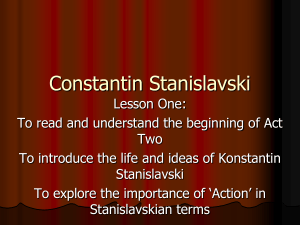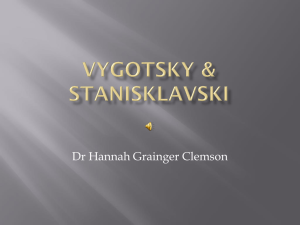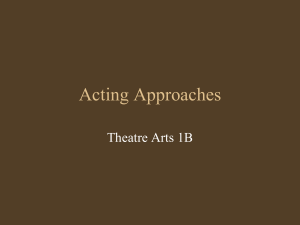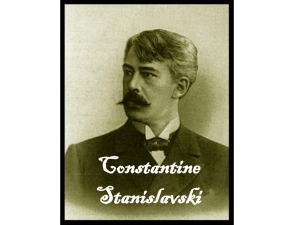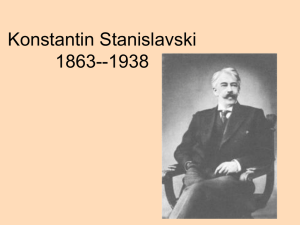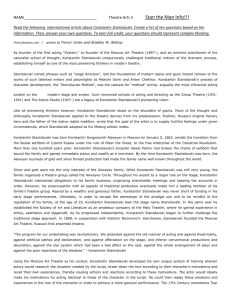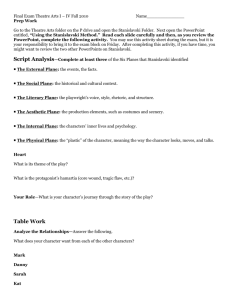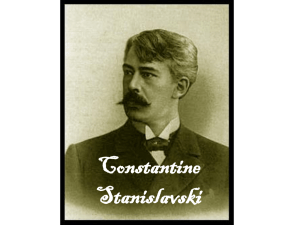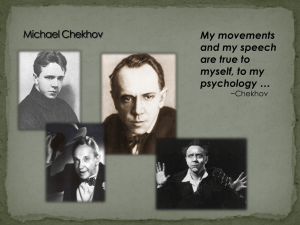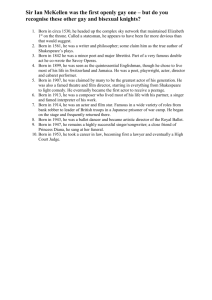Theatre Styles Master Class 2011 Focus: Hedda Gabler Constantin
advertisement
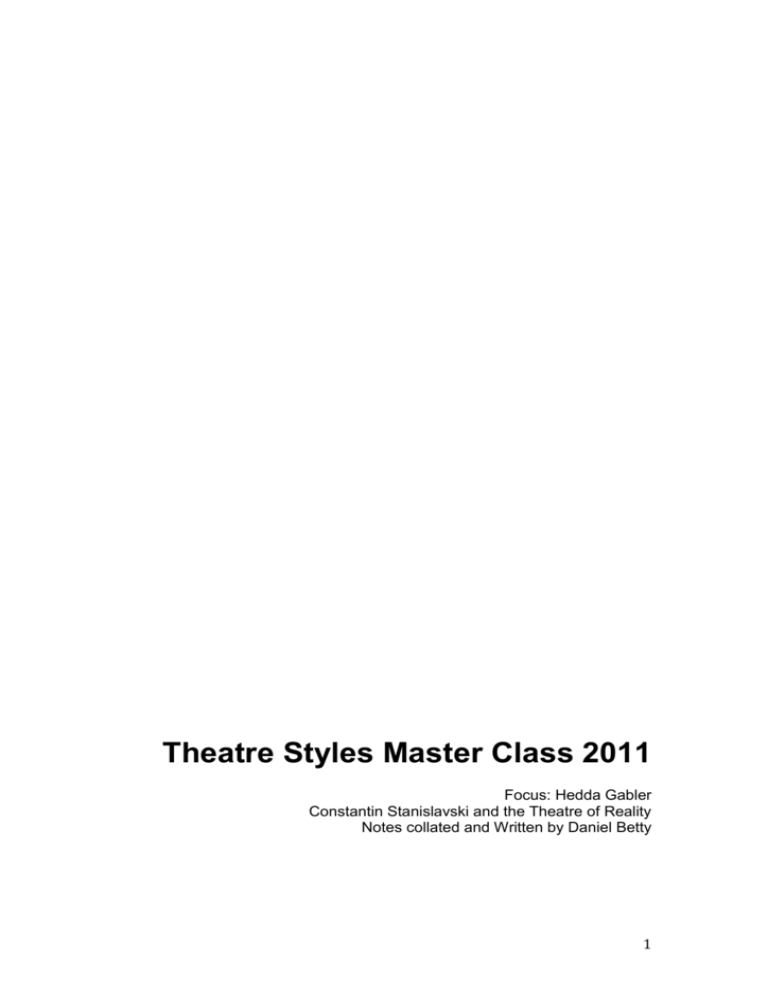
Theatre Styles Master Class 2011 Focus: Hedda Gabler Constantin Stanislavski and the Theatre of Reality Notes collated and Written by Daniel Betty 1 Contents Pg.3-6 Stanislavski’s System Pg.7 Stanislavski System Script Pg.8-12 Basic Principles for Analysing Text and Creating Character 2 Activity one Stanislavski’s System Duration This activity will take place over three lessons (45 minutes to one hour will allow students enough time to complete the task). Preparation Teacher is to print off short script for each student and the basic principles of analysing a text and creating a character. Give both of these documents to the students and ask them to read them before they come to the next lesson as homework. Ask them to not memorise the lines or make concrete decisions, as they don’t know whom they are going to be working with on the task. Description of Activity Lesson One Write on the board the basic principles of Stanislavski’s System. Make sure that the students are clear that Stanislavski is a naturalistic style of theatre and they will be exploring the following terminologies in a practical and reflective process. Stanislavski’s System Truth, Belief and the ‘Magic If’ Imagination Subtext Motivation Relaxation Units and Objectives Through line of actions and the Super Objective Tempo- Rhythm Emotional Memory Play Against Muscular Memory Given Circumstance Leave a gap around these so throughout the lesson(s) you can write outcomes of the practical explorations. Ask the students to get them selves into a group of four for the lesson. If you have an odd number create one group of five. Explain to the students that Stanislavski believed that the Given Circumstance (environment/ evidence of 3 your character or setting) was important for the actors as it could initiate responses, make us feel a particular way and is the world of the actor for that moment. The more that the student beliefs in this the more truthful the student will be in their use of space within their given circumstance. Get each group into their own space within the room and outline the imaginary space that they will be working in. The group is to discuss what they are going to transform this space into for their audience by miming a series of actions. To begin with choose a room within a house like; lounge, kitchen, bedroom or balcony. Within these spaces there are a number of objects that the students can create and use within the space. Once they have decided where they are get them to discuss what and where objects are within the room. One student is to then enter the room and use one of these objects in their own way. Remind them that they are trying to be truthful to their action. This is using their muscular memory and they are to remember what it was like to read a book sitting on the floor, watching television, lighting the fire or getting a drink of juice from the fridge. Ask them to live in the moment and not to self analyse but to commit to the action. Once they feel like they have completed this action they are to leave the space and the next student is to enter. This student is to then complete the first persons action and then their own action within the space. The group will continue in this way until each person has been into the space and created an action. Encourage the students to not rush this process and to give weight to each action. Once each group has finished go to the board and reflect on the process by writing responses to the Stanislavski terminologies; Muscular Memory, Imagination, Truth-Belief and Given Circumstance. Get the groups to go back to their imaginary space and this time we are going to give the students themes to explore and see how this affects their performance within this space. Each group this time however is going to perform for the rest of the class and the teacher is going to guide them through by giving each student an energy or stimulus before they enter the scene. Remind the students that they are finding truth by using imaginary circumstances and believing ‘as if’ events, situations or sensory recalls are or have happened. Don’t explain the principal of ‘play against’ at this point, as it should happen naturally throughout this process with one or two of the students. Make a note when you see this happening in performance and discuss it at the end of the process. Get the first group up and ask what actions they played in the space and where they were in the first activity. Explain to the students that they are going to do the same actions but the teacher will give them a theme and situation to project to their audience by using expressive skills. For Example Theme Situation 4 Relationships You have just broken up with your partner and it was your fault. You have just found out your best friend has told everyone your deepest secret. You are struggling fitting in. You miss being younger and having no responsibility. Create other situations around each of the themes to effect their character as they enter. Encourage them to play the truth. A good way to do this is to remind them to not show us your emotive state but think it and know it will come across to your audience. After each performance get the students to comment on what they saw and to comment on each of the performances. As Stanislavski’s terminologies are discussed make notes on the board and draw the students attention to this. This activity will take the majority of the lesson. Before the students leave ask them to read through the Stanislavski terminologies again and to read the script as they will be rehearsing and performing this over the next two lessons. Lesson Two When the students come in ask them to find a partner with whom they will work with on this scene. Make sure you have a few extra copies as some students may have left the script at home. Once they have all arrived get them to go into their own space around the room and start to rehearse. Throughout the lesson get the attention of the group at times and add to the Stanislavski notes on the board. If a pair comes to you halfway through the lesson and says that they are finished ask to see their performance. If you feel that they could add more to it offer some guidance. If however the performance is very good let them work with others to offer direction. Lesson Three This is a chance for the students to view each other’s work and for the teacher to workshop a few groups in front of the class. Give the students at least 10 minutes to rehearse their performance and then get them to come together in the space. Watch all of the performances and take notes throughout. Choose two groups whom you know will feel comfortable being work shopped in front of their peers and challenged to take their performance further. Reflective Questions 1. How has Stanislavski’s terminologies helped your understanding of finding truth of a character? 2. Choose one of the Stanislavski terminologies and describe when you 5 applied this to your performance and how it enhanced the character. 3. Have these activities helped you to understand the term naturalistic theatre? What is it? 4. What was a performance that you thought exemplified naturalistic theatre and encaptured Stanislavski’s principles? How did the performer do this? (discuss this in terms of both Stanislavski’s system and expressive skills of acting). 6 Stanislavski’s System Script When you are analysing the script please answer the questions in the right hand column to guide you through the creation of the scene and the characters. Please memorise the lines and rehearse your performance until you feel comfortable to perform in front of an audience. Remember even though you are playing characters you need to find the truth underneath the lines (subtext) to make your audience believe in who these people are, where they are (given circumstance) and why they are having this conversation. Stanislavski’s System Script A) That’s nice. B) Do you think so? (Silence) The following is a list of questions to help stimulate the use of Stanislavski’s System when creating this scene. Where are you? – This is your given circumstance and where your scene will be set. Use muscular memory to establish the scene throughout the performance. What is your motivation within the scene? – What drives you to be in this scene? How can you use emotional recall, observation or the ‘Magic If’ to create this motivation for the character? What is your relationship? – Create a history between these characters and place subtext underneath the lines. This will affect how you say the lines in relation to pitch, tempo and volume. What are your units or objectives in the scene? – In other words what are you doing and can you create a series of internal or external actions to complete to aide your character to pursue your super-objective. Are you playing against an emotion? If so what are you doing? – This will add another layer of truth to your performance make sure there is a logical reason for you to be playing against this emotion. A) Well it’s got a certain…… style. (Pause) Don’t you think? B) Do you want to know what I think? A) God forbid B) I think it’s terrible! A) Do you? B) Awful (whispering and then leaves) A) Oh, I like it 7 Stanislavski’s System Basic Principles for analysing a text and creating a character The following is a breakdown of some terminologies used in Stanislavski’s System to assist students in analysing a text and creating a character. This system will help the actor make choices about how they will use their expressive skills to communicate meaning and shape the character. Terminologies Definition Truth, Belief and the ‘Magic If’ Stanislavski stated that truth on stage was different from truth in real life. This was an important factor in acting, especially so in realism where the aim of the actor was to create the appearance of reality or ‘truth’ on stage. In the Stanislavskian technique, as in most other theatre training techniques, an actor does not actually believe in the truth of the events on stage, only in the imaginative creation of them. Indeed, an actor who honestly believed himself to be Hamlet would be deeply deluded and in need of psychiatric help. This then posed the problem of creating the appearance of reality for the spectator. Stanislavski’s answer to this problem was in the creation of the ‘Magic If.' The actor tried to answer the question, “If I were in Macbeth’s position, what would I do?” Thus, the character’s objectives drove the actor’s physical action choices. Through the stimulus of the powerful ‘if,' an actor could make strong theatrical choices that would appear to the audience as real, true and believable. In Stanislavski’s opinion, the actor who had the ability to make the audience believe in what he/she wanted them to believe, achieved ‘scenic truth.' Stanislavski defined ‘scenic truth’ as that which originated ‘on the plane of imaginative and artistic fiction.' This he differentiated from truth that was ‘created automatically and on the plane of actual fact’ (Stanislavski, AAP 128). The success of this scenic truth, according to Stanislavski, then constituted ‘art’ on stage. Imagination Stanislavski likened the study of his ‘Method of Physical Actions’ to a study of the grammar of a language. He cautioned however, that just as knowledge of grammar alone does not guarantee beautiful writing, knowledge of his techniques was only useful to an actor if accompanied by a fertile imagination. Stanislavski reiterated the use of the ‘theatrical’ and ‘imaginative’ faculties rather than trying to copy reality by rote: ‘There is no such thing as actuality on the stage. Art is a product of the imagination, as the work of a dramatist should be. The aim of the actor should be to use his technique to turn the play into a theatrical reality. In this process imagination plays by far the greatest part.’ (Stanislavski, AAP 54) Obviously, all the different aspects of the Stanislavski System required the actor to posses a rich source of imagination. The more fertile the actor’s imagination, the more interesting would be the choices made in terms of 8 objectives, physical action and creating the given circumstances around the character. Subtext An important function served by imagination was to discover and fill in ‘subtext.’ Subtext referred to the meaning lying underneath the text/dialogue. This subtext would not be spoken, but rather, interpreted by the actor through intonation, gesture, body posture, pauses or choices in action. Thus, through the actor’s imagination, the subtext ‘spoke’ to the audience. Stanislavski said: “Spectators come to the theatre to hear the subtext. They can read the text at home” (Moore 28). This reiterated the importance that subtext played in the Stanislavski System. The Moscow Art Theatre’s productions of Chekhov’s plays used subtext extensively. In fact Chekhov’s plays, known for their silences, lent themselves well to the use of subtext. For Stanislavski, subtext added texture and richness to an action. According to him, even a truthfully executed action would fall flat without subtext. The spectators would want to be involved in the causes of the character’s behavior, emotions and thoughts. Motivation Motivation or ‘will’, as Stanislavski called it, was part of a triumvirate, the other two members being ‘feelings’ and ‘mind.' In his earlier techniques, he considered these three to be ‘masters’ or ‘impelling movers in our psychic life’ (Stanislavski, AAP 247). Stanislavski insisted that an actor was either driven by emotions or by the mind to choose physical actions. This in turn aroused the ‘will’ of the actor to perform the given actions. Thus, the ‘will’ became activated indirectly through either emotions or the mind. The implication here was that the ‘will’ or motivation was in the subconscious. Richard Hornby, in distinguishing motivation from objective offers a plausible explanation. He posits that ‘motivation’ looks backwards into psychology and the past, while ‘objective’ looks forward towards an action. Motivation then becomes extremely important in psychological realism which is based on subtext and hidden meanings. Interestingly enough, theatrical styles before realism (and before psychology), Hornby notes, did not use motivation in characterization. Shakespeare’s characters, for instance, did not exist before the play, i.e., they had no history prior to the script. Hence, they did not use motivation. The same can be said for certain avant garde and post realistic drama. In Beckett, for instance, characters have no ‘motives,' but they do have objectives. Motivation therefore, is a product of modern psychological influences in acting. Relaxation Stanislavski’s thoughts on relaxation were based on the premise that in order to achieve control of all motor and intellectual faculties, the actor 9 needed to relax his muscles: ‘Muscular tautness interferes with inner emotional experience’ (Stanislavski, AAP 96). However, his line of reasoning on this was somewhat unclear. On one hand he quite rightly identified muscular tautness as the cause for several constrictions in performance. Some of these constrictions could be loss of fullness of voice, a ‘wooden’ physical appearance, or the blockage of creativity. These concerns were valid because actors have been known to ‘clam up’ through muscular tension. However his suggestion that only when an actor was totally relaxed, could the performance be any good, is problematic. Let us consider his statement for a moment, with regard to ballet, a highly disciplined art form. When ballerinas appear to effortlessly glide, leap, pirouette, they are not completely relaxed, but hold certain abdominal muscles tightly in. They also stretch or contract other muscles in order to achieve that fluidity of motion. In fact, if they were totally relaxed, they would lose energy, form and not be able to achieve their high level of artistry. Units and Objectives Stanislavski developed points of reference for the actor, which is now generally known as units and objectives. A unit is a portion of a scene that contains one objective for an actor. In that sense, a unit changed every time a shift occurred in a scene. Every unit had an objective for each character. This objective was expressed through the use of an active and transitive verb; for example, to seduce her or to annoy him. This active (action driven) objective then had corresponding physical action(s) that would help to achieve the objective. The objective was directed towards another person in order to ensure interaction. For example, to remember or to think would not be valid objectives, because they could not be directed towards another person. This would result in introspective and self-indulgent acting, rather than communication with others on stage. Through line of actions and the Super-Objective When objectives were strung together in a logical and coherent form, a through line of action was mapped out for the character. This was important in order to create a sense of the whole. Stanislavski developed the concept of the Super-objective that would carry this ‘through line of action.’ The super-objective could then be looked at as the ‘spine’ with the objectives as ‘vertebrae.’ For example, the superobjective of one character could be to win back the love of the other character. In order to achieve this super-objective, the first character would have successive unit objectives such as, to tease her, to please her, to excite her, to provoke her and to placate her. These objectives, when strung together, revealed the super-objective; the logical, coherent through line of action. Stanislavski called this super-objective the ‘final goal of every performance’ (Moore 49-50). 10 Tempo-Rhythm Tempo-rhythm can act as a powerful bridge between the inner experience and its physical expression (Moore 41). For Stanislavski, tempo-rhythm was both inner and outer. Emotions to him had a distinctive pulse and pattern to them. ‘Tempo’ referred to the speed of an action or an emotion. The tempo could be fast, medium or slow. ‘Rhythm’ was, internally, the intensity of the emotional experience. Externally, it was the pattern of gestures, movements and actions (Benedetti 48). Stanislavski believed that tempo-rhythm was extremely vital in order to execute physical actions in a concrete and truthful manner. As early as 1918, Stanislavski understood the importance of physically and emotionally giving richness to a character through the understanding and creation of tempo-rhythm. He likened the temporhythms of action to those of music. Just as music had various movements like legato, staccato, andante or allegro in a continuous line, so should stage action and speech. This would not only make the action organic, but also help stir the actor’s emotions. Emotional Memory Emotional Memory requires that an actor recreate an event from the distant past in order to regenerate the ‘feelings’ experienced at that time. These feelings, thus regenerated, are then used in the current acting situation in order to fill out the role with ‘human depth and personal involvement’ (Benedetti 66). The necessity of the event being from the distant, rather than recent, past is because Stanislavski felt (at that time) that time distilled events and feelings, acting as a ‘splendid filter for remembered feelings.’ Stanislavski believed that the quality of the actor’s performance depended upon the sincerity of his experience. This sincere experience went through a ‘time filter’ that transformed the quality of the experience into a ‘poetic reflection of life’s experience’ (Stanislavski quoted. in Moore 42). On stage the actor lived, not a real life, but a true stage experience. From this, one can gather that stage emotion is not the same as emotion in life, because as Stanislavski put it, on stage it is a ‘repeated’ experience, not a ‘primary’ one. The actor can stir the needed emotion in him/ herself by remembering a parallel situation having a similar emotion. This emotion would then need to be brought out at the exact moment when called for on stage. This ‘evoking’ of past experience was called ‘Emotional Recall.’ Thus, through rehearsal and training techniques, the actor developed a conditioned reflex. Play Against When exploring the subtext beneath a line Stanislavski believed that we often played against the truth to imply to our fellow actor or audience that we were feeling a different emotive state. For example a past event has made you emotionally exhausted but you portray to your fellow actors in the present time that you are fine. This added another layer of truth, as the audience feels empowered as they know past events and can see how the character reacts to internal problems and 11 how it affects their expressive skills as a character. Muscular Memory Is how our body remembers and refines body-movement. Stanislavski believed that our body could recall specific action play whether we had the props or not and create the action believably for our audience. Given Circumstance The setting in which the scene is situated is called the ‘given circumstance’. This environment could be shown through set, props or other stagecraft. It could also be shown using the non-naturalistic elements of mime. 12
